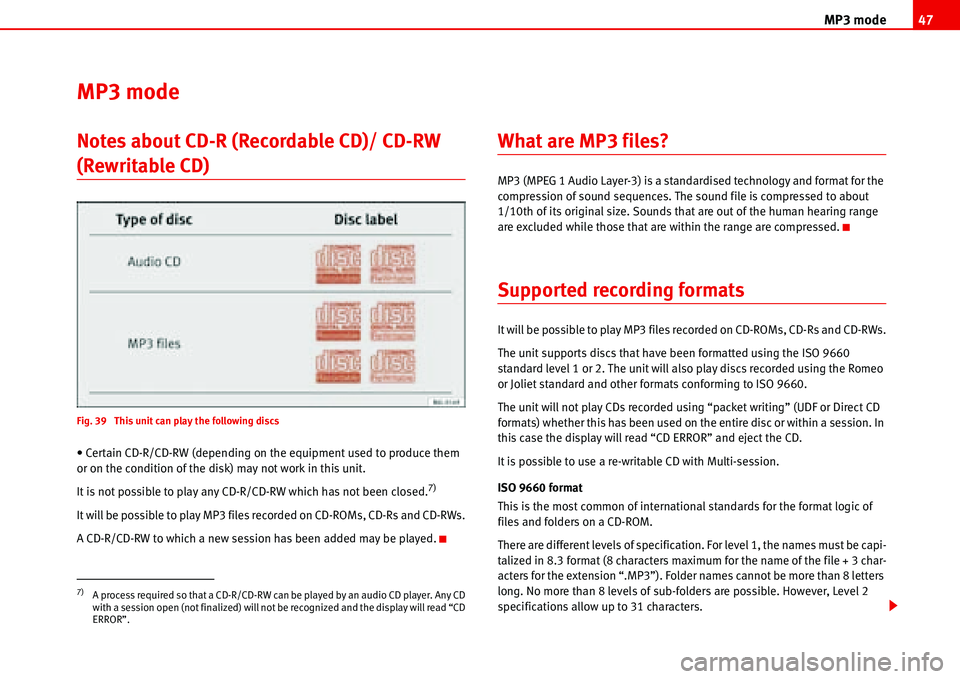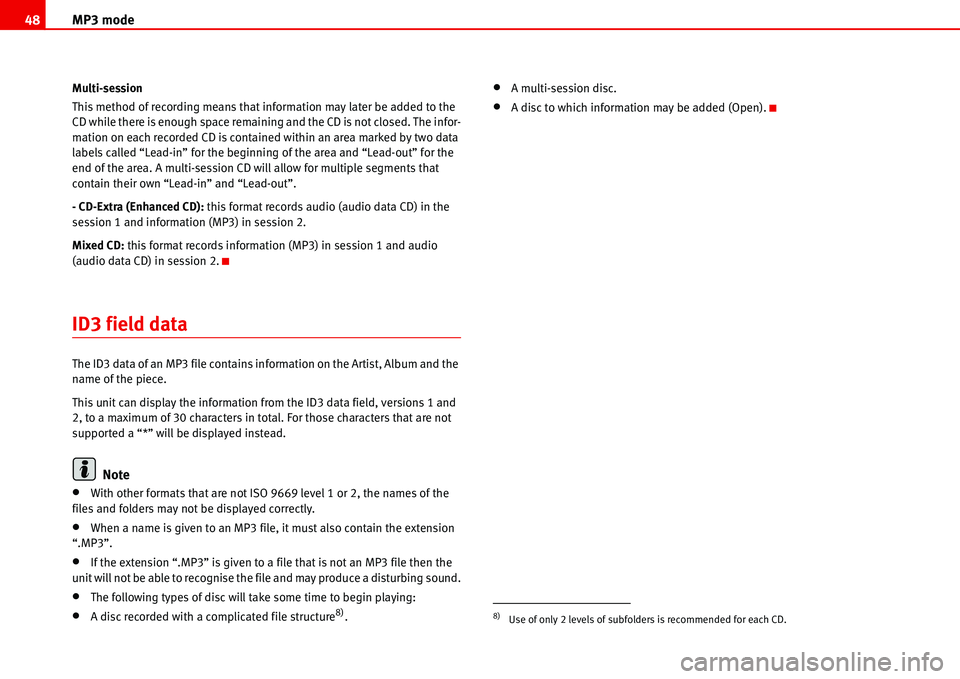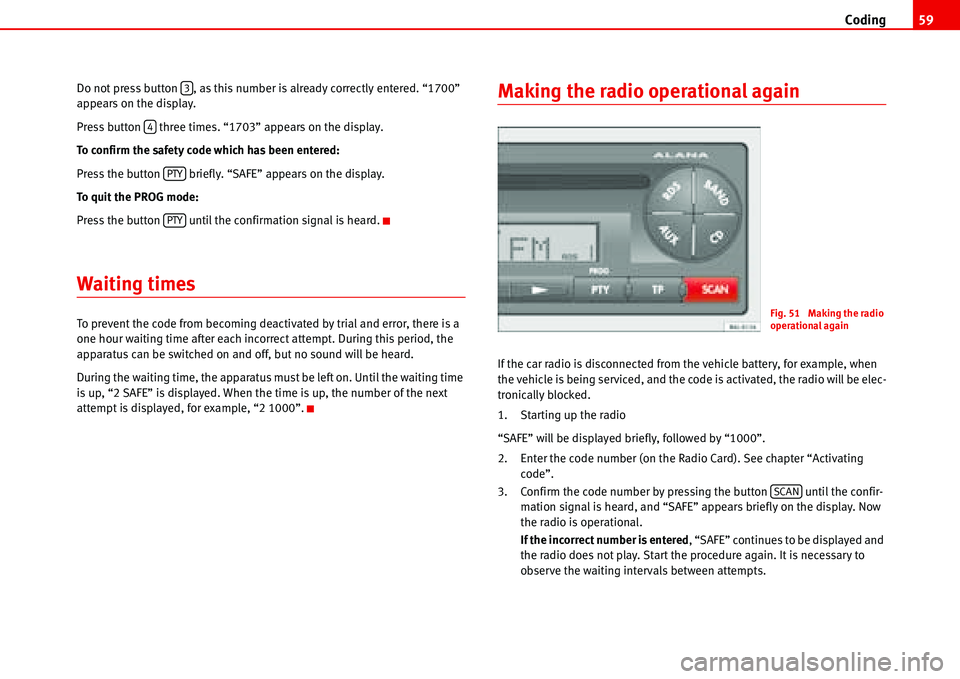Page 50 of 70

MP3 mode47
MP3 mode
Notes about CD-R (Recordable CD)/ CD-RW
(Rewritable CD)
Fig. 39 This unit can play the following discs
• Certain CD-R/CD-RW (depending on the equipment used to produce them
or on the condition of the disk) may not work in this unit.
It is not possible to play any CD-R/CD-RW which has not been closed.
7)
It will be possible to play MP3 files recorded on CD-ROMs, CD-Rs and CD-RWs.
A CD-R/CD-RW to which a new session has been added may be played.
What are MP3 files?
MP3 (MPEG 1 Audio Layer-3) is a standardised technology and format for the
compression of sound sequences. The sound file is compressed to about
1/10th of its original size. Sounds that are out of the human hearing range
are excluded while those that are within the range are compressed.
Supported recording formats
It will be possible to play MP3 files recorded on CD-ROMs, CD-Rs and CD-RWs.
The unit supports discs that have been formatted using the ISO 9660
standard level 1 or 2. The unit will also play discs recorded using the Romeo
or Joliet standard and other formats conforming to ISO 9660.
The unit will not play CDs recorded using “packet writing” (UDF or Direct CD
formats) whether this has been used on the entire disc or within a session. In
this case the display will read “CD ERROR” and eject the CD.
It is possible to use a re-writable CD with Multi-session.
ISO 9660 format
This is the most common of international standards for the format logic of
files and folders on a CD-ROM.
There are different levels of specification. For level 1, the names must be capi-
talized in 8.3 format (8 characters maximum for the name of the file + 3 char-
acters for the extension “.MP3”). Folder names cannot be more than 8 letters
long. No more than 8 levels of sub-folders are possible. However, Level 2
specifications allow up to 31 characters.
7)A process required so that a CD-R/CD-RW can be played by an audio CD player. Any CD
with a session open (not finalized) will not be recognized and the display will read “CD
ERROR”.
Page 51 of 70

MP3 mode 48
Multi-session
This method of recording means that information may later be added to the
CD while there is enough space remaining and the CD is not closed. The infor-
mation on each recorded CD is contained within an area marked by two data
labels called “Lead-in” for the beginning of the area and “Lead-out” for the
end of the area. A multi-session CD will allow for multiple segments that
contain their own “Lead-in” and “Lead-out”.
- CD-Extra (Enhanced CD): this format records audio (audio data CD) in the
session 1 and information (MP3) in session 2.
Mixed CD: this format records information (MP3) in session 1 and audio
(audio data CD) in session 2.
ID3 field data
The ID3 data of an MP3 file contains information on the Artist, Album and the
name of the piece.
This unit can display the information from the ID3 data field, versions 1 and
2, to a maximum of 30 characters in total. For those characters that are not
supported a “*” will be displayed instead.
Note
•With other formats that are not ISO 9669 level 1 or 2, the names of the
files and folders may not be displayed correctly.
•When a name is given to an MP3 file, it must also contain the extension
“.MP3”.
•If the extension “.MP3” is given to a file that is not an MP3 file then the
unit will not be able to recognise the file and may produce a disturbing sound.
•The following types of disc will take some time to begin playing:
•A disc recorded with a complicated file structure8).
•A multi-session disc.
•A disc to which information may be added (Open).
8)Use of only 2 levels of subfolders is recommended for each CD.
Page 53 of 70
MP3 mode 50
Note
The WMA audio files are recognised by the player but are not played.
Display mode (SCAN button)
Fig. 41 Display mode
Page 62 of 70

Coding59
Do not press button , as this number is already correctly entered. “1700”
appears on the display.
Press button three times. “1703” appears on the display.
To confirm the safety code which has been entered:
Press the button briefly. “SAFE” appears on the display.
To quit the PROG mode:
Press the button until the confirmation signal is heard.
Waiting times
To prevent the code from becoming deactivated by trial and error, there is a
one hour waiting time after each incorrect attempt. During this period, the
apparatus can be switched on and off, but no sound will be heard.
During the waiting time, the apparatus must be left on. Until the waiting time
is up, “2 SAFE” is displayed. When the time is up, the number of the next
attempt is displayed, for example, “2 1000”.
Making the radio operational again
If the car radio is disconnected from the vehicle battery, for example, when
the vehicle is being serviced, and the code is activated, the radio will be elec-
tronically blocked.
1. Starting up the radio
“SAFE” will be displayed briefly, followed by “1000”.
2. Enter the code number (on the Radio Card). See chapter “Activating
code”.
3. Confirm the code number by pressing the button until the confir-
mation signal is heard, and “SAFE” appears briefly on the display. Now
the radio is operational.
If the incorrect number is entered, “SAFE” continues to be displayed and
the radio does not play. Start the procedure again. It is necessary to
observe the waiting intervals between attempts.
3
4
PTY
PTY
Fig. 51 Making the radio
operational again
SCAN